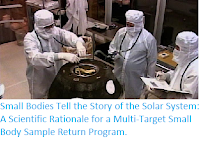The Japan Aerospace Exploration Agency has confirmed that samples from Asteroid Ryugu have been collected within the sample container inside the re-entry capsule of the asteroid explorer, Hayabusa2, in a press release issued on 14 December 2020. The Hayabusa2 re-entry capsule was recovered in Woomera, Australia on 6 December 2020 and delivered to the Japan Aerospace Exploration Agency's Sagamihara Campus on 8 December. Work then began to open the sample container inside the re-entry capsule. On 14 December, a sample of grains of black sand thought to be derived from Asteroid Ryugu was confirmed to be inside the sample container. These are believed to be particles attached to the entrance of the sample catcher (the container in which the samples have been stored). Work will continue with opening the sample catcher that sits in the sample container. The curation and initial analysis team will remove the samples and proceed with the analysis.
Hayabusa2 is the sequel to the Hayabusa probe, designed for returning asteroid samples. By investigating a different type of asteroid (type C) from the Itokawa asteroid (type S) that was the target of Hayabusa, Hayabusa 2 was intended to explore not only the origins of the planets but also the origin of the water of Earth’s oceans and the source of life.
Hayabusa 2 more or less followed the sample return method carried out by the first Hayabusa. However, many improvements were made to increase reliability so that missions could be completed with greater accuracy. The probe usied new technology such as a device for creating artificial craters on the surface of the asteroid and carrying back samples of the underground soil. Improving probe technology for astronomical objects in the solar system is an important goal of Hayabusa 2.
Hayabusa 2 aimed to examine the Ryugu Asteroid (162173). Ryugu is a type C asteroid, but it is believed that there were organic matter and water on the asteroid when the solar system was created (roughly 4.6 billion years ago) and that these still exist. The second goal of Hayabusa 2 was to solve questions such as where the Earth’s water came from and where the organic matter which makes up life was created. A third goal of Hayabusa 2 was to examine how the planets were created through the collision, destruction, and combination of the planetesimals which are thought to have been created first.
See also...


Follow Sciency Thoughts on Facebook.
Follow Sciency Thoughts on Twitter.







